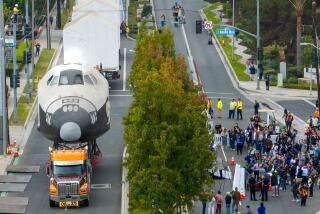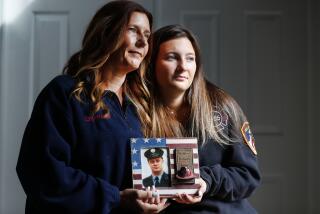Challenger Crew Memorialized by Air Museum
WASHINGTON — Though most Americans never met the seven Challenger crew members, they shared with them perhaps the most intimate bond humans can have.
They watched them die.
The same kind of baffling technology that makes it possible to hurl people into space also allowed millions of Americans to turn a knob on a box and watch people perish, right before their eyes, in a fiery instant.
Many were left grieving with no place to go, no way to express it.
But others flocked to the Smithsonian’s Air and Space Museum on Wednesday, where they dabbed tears, left flowers, watched a movie with two of the late astronauts in it and viewed a simple memorial plaque hastily hung in an exhibit about the space shuttles.
A memorial ceremony had quickly been arranged. On only a half-day’s notice, three senators, including former astronaut John Glenn (D-Ohio), Jim Sasser (D-Tenn.) and shuttle passenger Jake Garn (R-Utah), joined Education Secretary William Bennett, three congressmen and the museum’s director to speak at the unveiling of the plaque.
A temporary exhibit to be replaced by something permanent, it was the barest of plaques in a flashy museum, really nothing more than a poster with the word Memoriam across the top, a black and white picture of the crew, their names and short biographies, and a one-sentence explanation that hit like a hammer:
“The crew of mission 51-L was lost shortly after a launch aboard the shuttle Challenger from NASA’s Kennedy Space Center as a result of an in-flight explosion.”
The plaque, draped in black ribbons, was hung on a glass wall, beside a scale model of the shuttle at launch. Two uniformed guards stood at either side of the plaque.
People photographed the plaque, read it and, for many silent moments, just stood and stared at it.
“This was like a pilgrimage,” said Wanda Holcombe, a Dallas office administrator in town for an architecture convention. She had stared at the plaque and carefully read all the exhibits around it.
“I wanted to see the spacecraft in which the lives were lost,” Holcombe said, “as a way to honor them and to pay homage to the people who went out to explore the future of our children.
“I didn’t expect this,” she said of the plaque. “I’m deeply appreciative that this has been done.
“It’s so quiet. It’s quite humbling to see all this.”
After the accident, the museum received more than 100 calls asking if any of the astronauts who had been killed were in the film that has been showing there, featuring spectacular footage taken on board several shuttle flights.
Technical operations manager Steven Fitch told callers that yes, two of the astronauts--Francis (Dick) Scobee and Judith Resnik--were in the film. Chillingly, the film is called “The Dream Is Alive.”
On the day of the explosion, attendance at the movie was down about 500 people from the norm. But the day after the explosion, as a heavy snow fell, attendance was 2,300, about 500 more than average and 1,000 more than the previous day.
Came as a Memorial
“They come almost as a memorial,” said Fitch, who had a color picture of the Challenger crew on a table in his office. “I can hear them saying, ‘That’s Dick Scobee. That’s Judy Resnick,’ and see them pointing.”
Within hours of the mishap, the museum had added a precede to the film, a still color slide of the crew with the words “In Memoriam,” and a sentence informing viewers that two of the astronauts are in the film.
Usually the launch scenes on the seven-story screen evoke oohs and ahs and sometimes cheers and whistles. But Wednesday, there was a tense silence as viewers watched footage of a previous shuttle liftoff. Two words that people never noticed before brought chills or tears as a voice in the movie said to a soaring spacecraft, “Throttle up.”
There are scenes of Scobee laughing in triumph after the crew has snared some errant satellite, and a shot of Resnick looking beautiful and peaceful, sound asleep in the shuttle’s sleeping quarters.
Gerald Lytle, 51, of Columbia, Pa., wiped his tears and blew his nose a few times during the movie. It’s not as if Lytle is a stranger to death and tragic scenes. He is a priest.
“After the accident, I wanted to see it,” Lytle said. “It was moving, yes. I was thinking about the teacher. They’re paving the way to the future.”
Ronald Amalong brought his son, Mathew, and the entire sixth-grade class of Park Maitland school in Florida to see the film Wednesday. Mathew, 11, thought the movie was “real neat” and said he was “not scared” about space exploration.
Names of the Dead
A signboard normally used to inform visitors of special daily programs on Wednesday said only “In Memoriam” and listed the names of the dead. Beside it, on the floor, someone had left a single rose. Another person, someone identified only as Gregory Baker, could not wait for Wednesday to express himself. He taped a handwritten note on a museum door, apparently after it had closed Tuesday.
The note said: “We are saddened and shocked. A moment’s freedom, a moment’s exultation. And now tragedy.
“And yet, though we mourn and we remember those who died, life goes on and we must continue outward and onward.”
More to Read
Sign up for Essential California
The most important California stories and recommendations in your inbox every morning.
You may occasionally receive promotional content from the Los Angeles Times.










